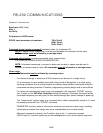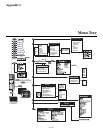
GLOSSARY
Checkbox A menu item that indicates whether an option is currently in effect (checked) or
not (unchecked).
Color Shift A change in the color of a white field across an image (white field uniformity).
Color Temperature The coloration (reddish, white, bluish, greenish, etc.) of white in an image, meas-
ured using the Kelvin (degrees K) temperature scale. Higher temperatures appear
bluer, while lower color temperatures appear redder.
Component Video See YCbCr or YPbPr.
Composite Video The output of video tape players and some computers, characterized by synchro-
nization, luminance and color signals combined on one output cable.
Contrast (ratio) The degree of difference between the lightest and darkest areas of the image.
Convergence The alignment of the red, green, and blue elements of a projected image.
Curved Screen A projection screen which is slightly concave for improved screen gain. Curved
screens usually have screen gains which are greater than 1 but viewing angles
much less than 180°. Curved screens are not recommended for use with this pro-
jector.
DDI A Direct Digital Interface signal can be supplied to the projector via an optional
digital input module installed in INPUT 2. For example, you can input an SMPTE-
259M signal using a Serial Digital Input Module or input an SMPTE-272M signal
from a HDTV Serial Input Module.
DMD
Digital Micromirror Devices used in this projector for processing red, green, and
blue color data.
Decoder Located at INPUT 3 and INPUT 4, this device converts NTSC 3.58, NTSC 4.4,
PAL, PAL-N, PAL-M, or SECAM to RGB video.
Detail The sharpness of a display from a video source.
Diffused Screen A type of rear-projection screen which spreads the light striking it. Screen gain is
less than 1 but audience viewing angles are increased.
Display Setting An adjustment that affects the display of an image. Such display settings include
contrast, brightness, tint, blanking, size, offsets, and others.
Flicker A very rapid variation in image brightness caused by a frame rate that is too slow.
(See Interlace.)
Frame Rate The frequency at which complete images are generated. For non-interlaced sig-
nals, the frame rate is identical to the vertical frequency. For interlaced signals, the
frame rate (also known as field rate) is one half of vertical frequency.
Foot-candle The intensity of visible light per square foot.
Foot-lambert The luminance (brightness) which results from one foot-candle of illumination
falling on a perfectly diffuse surface.
Gain or Screen Gain The ability of a screen to direct incident light to an audience. A flat matte white
wall has a gain of approximately 1. Screens with gain less than 1 attenuate inci-
dent light; screens with gain more than 1 direct more incident light to the audience
but have a narrow viewing angle. For example: An image reflecting off a 10 gain
screen appears 10 times brighter than it would if reflected off a matte white wall.
A-2


















